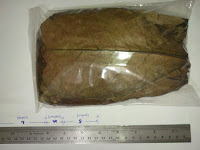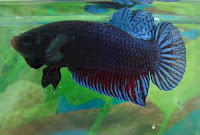
Usage of Ketapang Leaves for Arowanas ?
"...The brownish-yellow color of black water is believed to contribute to the bright,iridescent colors typical of many black water fish species, including Arowanas. Vibrant coloration may make it easier for species to spot each other in darkly colored water.
Many hobbyists and professional breeders prefer to reproduce black water conditions in their Arowana aquariums. Dried Ketapang leaves are used to promote a healthy environment, induce spawning, and lower the pH of tank water. The natural organic acids released by the leaves may help absorb undesirable..."
Full Article: HERE
" . . . One of the parameters that hobbyist can try to achieve is to provide a generally lower pH values (6 to 6.8) for their beloved arowanas. To Mr Tan, there are no specific pH values for either red or the golden variety. He mentioned also that arowanas prefers acidic and soft water those that contains trace elements like tannic acid. The use of ketapang leaves to create this soft water is highly recommended . . ."
Taken from link HERE
*****************************************************************
Most of the information presented in this blog are taken from the views of many arowana breeders & hobbyists, traders around the world.
*****************************************************************
"...The brownish-yellow color of black water is believed to contribute to the bright,iridescent colors typical of many black water fish species, including Arowanas. Vibrant coloration may make it easier for species to spot each other in darkly colored water.
Many hobbyists and professional breeders prefer to reproduce black water conditions in their Arowana aquariums. Dried Ketapang leaves are used to promote a healthy environment, induce spawning, and lower the pH of tank water. The natural organic acids released by the leaves may help absorb undesirable..."
Full Article: HERE
" . . . One of the parameters that hobbyist can try to achieve is to provide a generally lower pH values (6 to 6.8) for their beloved arowanas. To Mr Tan, there are no specific pH values for either red or the golden variety. He mentioned also that arowanas prefers acidic and soft water those that contains trace elements like tannic acid. The use of ketapang leaves to create this soft water is highly recommended . . ."
Taken from link HERE
*****************************************************************
Most of the information presented in this blog are taken from the views of many arowana breeders & hobbyists, traders around the world.
*****************************************************************

















